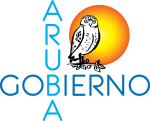Reforestation adds new meaning to historical heritage: The Roundabout is one of Aruba's oldest.
ORANJESTAD – The roundabout where the government officially launched the National Reforestation Program on July 14, 2025, has proven to be not only a symbolic starting point for a greener Aruba but also a place of deep historical significance.
New footage and archival photos show that this roundabout dates back to the 1930s, making it one of the oldest surviving roundabouts on the island. Old photos clearly show that an obelisk-like pillar with a distinctive T-shape at the top, from which streetlights hung, once stood in the center of the roundabout.
The roundabout predates the construction of the Grote Protestantse Kerk (Great Protestant Church). Its location was near some of the most iconic institutions of Aruba's colonial administration: the Government Office at Zoutmanstraat 1, the Governor's Office, and—later—the first police station, built right next to the roundabout. These new historical insights give the renovation and reforestation an additional cultural and symbolic dimension.
"The place where we planted hope for the future also turns out to be a place of memory and connection with our past," stated Prime Minister Mike Eman. "Rediscovering this history confirms how closely our identity is intertwined with our public spaces."
Nadine da Silva, an expert in nature development and coordinator of the reforestation program, also commented: "Green heritage is more than ecology. It is also cultural memory. The trees we will plant for the reforestation program will grow not only in soil but also in meaning. This roundabout connects generations."
Daphne Every, an architect specializing in monuments and historical spatial planning, emphasizes the value of this discovery: “This roundabout was once a vital landmark on the historic axis of old Oranjestad. In its immediate vicinity, you could find the authorities, the administration, the church, and the oversight—the core of Aruba at the time.
Restoring and revitalizing such a place means not only adding greenery but also restoring identity.” The adoption of the roundabout by fashion retailer Grupo BENNU (Zara) and the careful embellishment with natural stone edging and sustainable brick paving take on added significance with this historical context. The project demonstrates how public space can simultaneously carry ecological and historical value.
The roundabout creates a physical link between the past and the future by serving as a traffic hub for the administrative center and, more recently, as a symbol of ecological restoration.
